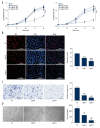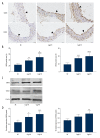Helicobacter Pylori Induces GATA3-Dependent Chitinase 3 Like 1 (CHI3L1) Upregulation and Contributes to Vascular Endothelial Injuries
- PMID: 31256192
- PMCID: PMC6621644
- DOI: 10.12659/MSM.916311
Helicobacter Pylori Induces GATA3-Dependent Chitinase 3 Like 1 (CHI3L1) Upregulation and Contributes to Vascular Endothelial Injuries
Abstract
BACKGROUND Helicobacter pylori infection is associated with various vascular diseases. However, its mechanism is yet to be defined. The present study aimed to investigate the effect of H. pylori on vascular endothelial cells as well as the GATA3-related mechanism of H. pylori infection-induced endothelial injuries. MATERIAL AND METHODS A co-culture of H. pylori with human umbilical endothelial cells (HUVECs) was produced. The proliferation of HUVECs that had been incubated with H. pylori were examined via CCK-8 (Cell Counting Kit-8) and EdU (5-ethynyl-2'-deoxyuridine) staining. Cell migration and microtubules formation were studied using Transwell and tube formation respectively. Construction of a mouse model of H. pylori infection as well as the expression of GATA3 and CHI3L1 in vessels were tested using western blot and immunohistochemistry. Small interfering RNA (siRNA) of GATA3 were transfected into HUVECs in order to establish cell lines with knocked-down GATA3. The production of the aforementioned molecules and p38 mitogen-activated protein kinase (MAPK) related molecules in HUVECs was measured using quantitative real-time polymerase chain reaction and western blot. RESULTS H. pylori significantly inhibited the proliferation, migration, and tube formation of HUVECs, as well as increased the production of the inflammatory factor CHI3L1 and phosphorylated p38 from endothelial cells along with an increased expression of GATA3. Elevated levels of the GATA3 and CHI3L1 were also found in the arteries of H. pylori-infected mice. Following GATA3 knockdown, the H. pylori-induced dysfunction of HUVECs was restored. CONCLUSIONS H. pylori impaired vascular endothelial function. This might be due to the H. pylori-induced increased expression of GATA3, as well as the GATA3 mediated upregulated CHI3L1 and activation of the p38 MAPK pathway.
Conflict of interest statement
None.
Figures





References
-
- Franceschi F, Zuccala G, Roccarina D, Gasbarrini A. Clinical effects of Helicobacter pylori outside the stomach. Nat Rev Gastroenterol Hepatol. 2014;11(4):234–42. - PubMed
-
- Sawayama Y, Ariyama I, Hamada M, et al. Association between chronic Helicobacter pylori infection and acute ischemic stroke: Fukuoka Harasanshin Atherosclerosis Trial (FHAT) Atherosclerosis. 2005;178(2):303–9. - PubMed
-
- Wan Z, Hu L, Hu M, et al. Helicobacter pylori infection and prevalence of high blood pressure among Chinese adults. J Hum Hypertens. 2018;32(2):158–64. - PubMed
MeSH terms
Substances
LinkOut - more resources
Full Text Sources
Medical

